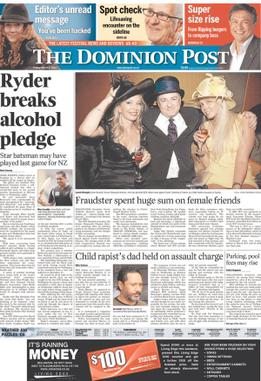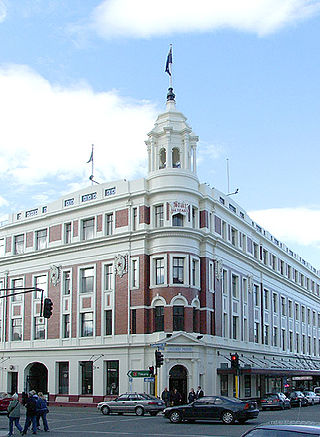Related Research Articles

Robert Semple was a union leader and later Minister of Public Works for the first Labour Government of New Zealand. He is also known for creating the Bob Semple tank.

The Dominion Post is a metropolitan daily newspaper published in Wellington, New Zealand. It is owned by media business Stuff Ltd, formerly the New Zealand branch of Australian media company Fairfax Media. Weekday issues are now in tabloid format, and its Saturday edition is in broadsheet format.

The New Zealand Herald is a daily newspaper published in Auckland, New Zealand, owned by New Zealand Media and Entertainment, and considered a newspaper of record for New Zealand. It has the largest newspaper circulation of all newspapers in New Zealand, peaking at over 200,000 copies in 2006, although circulation of the daily Herald had declined to 100,073 copies on average by September 2019. Its main circulation area is the Auckland region. It is also delivered to much of the upper North Island including Northland, Waikato and King Country.

The Mayor of Wellington is the head of the municipal government of the City of Wellington. The mayor presides over the Wellington City Council. The mayor is directly elected using the Single Transferable Vote method of proportional representation. The current mayor is Tory Whanau, elected in October 2022 for a three-year-term.

The Otago Daily Times (ODT) is a newspaper published by Allied Press Ltd in Dunedin, New Zealand. The ODT is one of the country's four main daily newspapers, serving the southern South Island with a circulation of around 26,000 and a combined print and digital annual audience of 304,000. Founded in 1861 it is New Zealand's oldest surviving daily newspaper – Christchurch's The Press, six months older, was a weekly paper until March 1863.

Capital punishment in New Zealand – the process of sentencing convicted offenders to death for the most serious crimes and carrying out that sentence, as ordered by a legal system – first appeared in a codified form when New Zealand became a British colony in 1840. It was first carried out with a public hanging in Victoria Street, Auckland in 1842, while the last execution occurred in 1957 at Mount Eden Prison, also in Auckland. In total, 85 people have been executed in New Zealand.

The Press is a daily newspaper published in Christchurch, New Zealand owned by media business Stuff Ltd. First published in 1861, the newspaper is the largest circulating daily in the South Island and publishes Monday to Saturday. One community newspaper—Northern Outlook- is also published by The Press and is free.
The New Zealand Listener is a weekly New Zealand magazine that covers the political, cultural and literary life of New Zealand by featuring a variety of topics, including current events, politics, social issues, health, technology, arts, food, culture and entertainment. The Bauer Media Group closed The Listener in April 2020 as a result of the COVID-19 pandemic in New Zealand. In June 2020, Mercury Capital acquired the magazine as part of its purchase of Bauer Media's former Australia and New Zealand assets, which were rebranded as Are Media.

John Norton was an English-born Australian journalist, editor and member of the New South Wales Parliament. He was a writer and newspaper proprietor best known for his Sydney newspaper Truth. Norton was arguably one of Australia's most controversial public figures ever.

John Gerald O’Brien, known as Gerald O'Brien, was a New Zealand politician of the Labour Party.

Thomas Charles Atkinson Hislop (29 November 1888 – 21 June 1965) was a New Zealand politician, lawyer, and diplomat. He served as the mayor of Wellington from 1931 to 1944.

Alexander Wilson Hogg was a member of parliament for Masterton, in the North Island of New Zealand.
The Maoriland Worker, later called The Standard, was a leading New Zealand labour journal of the early 20th century.

Henry William Cleary was the sixth Roman Catholic Bishop of Auckland, from 1910 to 1929.
Cameron Slater is a right-wing New Zealand-based blogger, best known for his role in Dirty Politics and publishing the Whale Oil Beef Hooked blog, which operated from 2005 until it closed in 2019. He edited the tabloid newspaper New Zealand Truth from November 2012 until it ceased publication in July 2013. Slater's father, John Slater, served as President of the New Zealand National Party from 1998 to 2001.
Arthur Beauchamp was a Member of Parliament from New Zealand. He is remembered as the father of Harold Beauchamp, who rose to fame as chairman of the Bank of New Zealand and was the father of writer Katherine Mansfield.
The Otago Witness was a prominent illustrated weekly newspaper in the early years of the European settlement of New Zealand, produced in Dunedin, the provincial capital of Otago. Published weekly, it existed from 1851 to 1932. The introduction of the Otago Daily Times, followed by other daily newspapers in its circulation area, led it to focus on serving a rural readership in the lower South Island, where poor road access prevented newspapers being delivered daily. It also provided an outlet for local fiction writers. It is notable as the first newspaper to use illustrations and photographs and was the first New Zealand newspaper to provide a correspondence column for children, which was known as "Dot's Little Folk". Together with the Auckland-based Weekly News and the Wellington-based New Zealand Free Lance it was one of the most significant illustrated weekly New Zealand newspapers in the 19th and early 20th centuries.
The New Zealand Tablet was a weekly Catholic periodical published in Dunedin from 1873 to 1996.
The 2014 Canon Media Awards were hosted by the New Zealand Newspaper Publishers' Association on Friday 9 May 2014 at the Pullman Hotel in Auckland, New Zealand. The Newspaper of the Year was The Dominion Post, and the Reporter of the Year was Andrea Vance of Fairfax Media's political bureau.
References
- ↑ Yska, Redmer (2010). Truth: The rise and fall of the people's paper. Nelson: Craig Potton Publishing. ISBN 9781877517303.
- ↑ "New Zealand and Pacific Newspapers and Magazines (University of Auckland newspaper holdings on microfilm)". Archived from the original on 14 May 2006.
- ↑ Yska, 2010, p. 15
- ↑ Yska, 2010, p. 19
- ↑ Gustafson, Barry (1980). Labour's Path to Political Independence. Auckland: Auckland University Press. p. 158. ISBN 0-19-647986-X.
- ↑ Yska, 2010, p. 144
- ↑ "Robin Hyde (Iris Wilkinson), 1906–1939". New Zealand Electronic Text Centre . Victoria University of Wellington. 2007.
- ↑ Yska, 2010, p. 125
- ↑ "Cameron Slater takes helm of Truth". 3 News NZ. 31 October 2012. Archived from the original on 16 October 2013. Retrieved 31 October 2012.
- ↑ "NZ Truth to cease publishing after 125 years – reports". The New Zealand Herald. 17 July 2013.
- ↑ "Archive of Truth website". 23 December 2014. Archived from the original on 23 December 2014.